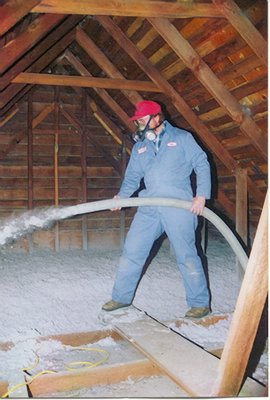
Daydreaming in his doctor’s office last week, Gordian Raacke had an unexpected “eureka” moment. And it had nothing to do with his health.
He realized that his yearly exam was much like a home energy assessment—a checkup that helps homeowners diagnose where their house is losing energy and money, and how those problems can be corrected to make the home more energy efficient, especially as temperatures drop.
“The doctor tells you, ‘You’re doing pretty good, but here’s a few things you may want to follow up on,’” Mr. Raacke, the executive director of Renewable Energy Long Island in East Hampton, said last week during a telephone interview. “Same thing with the energy audit. It’s basically like getting a physical for the home.”
Step one is applying for a home energy assessment, also known as an energy audit, which is free so long as the household income is less than $215,000—200 percent of the area median income. If higher, the audit is billed on a sliding scale and will cost no more than $250.
Step two is hiring a Building Performance Institute-certified contractor to execute the audit and administer health and safety tests, which can take one to three hours, according to Mr. Raacke.
“They hook your house up to a computer and they get some very accurate data on how your house is performing,” he said. “And then they produce a set of recommended measures to make your home more comfortable and save money. You’re in charge, you can pick and choose. You can say, ‘I’m going to do this one and that one,’ just like with your doctor. You may not want to do all the things the doctor recommends, but hopefully you’ll do a few of them.”
For the average household, energy efficiency has become a whole lot easier in the last few years. In 2011, the New York State legislature passed the On-Bill Recovery Loan Program, which allows homeowners to obtain loans for energy efficiency improvements through the New York State Energy Research and Development Authority. Without any money down, the improvements are made and the loan is repaid through a charge on the customer’s electric or gas utility bill.
The loans are usually designed so that the projected energy savings are equal or exceed monthly payments, Mr. Raacke reported, allowing homeowners to spend less—or break even—from day one. A homeowner can finance up to $25,000 if the payback period, or the amount of time it takes for the work to “pay for itself” in savings, is 15 years or less. If the payback period is longer than 15 years, the maximum amount is $13,000.
“Up to now, people didn’t really have the option for bill financing,” he said. “When presented with these options, which can cost a few thousand dollars, they were often overwhelmed when they saw a large figure. They would say, ‘I really don’t have that money right now.’ So now, compared to your other option—which is just doing nothing—you’re going to save money every month.”
The typical home on Long Island is a drafty sieve, Mr. Raacke explained, noting that a contractor once told him that the average house has enough crevices and cracks to end up with a hole 3 feet wide by 3 feet high.
“If you’re trying to heat your home and you have a window with no glass in it, it’s going to be difficult,” he said. “A good chunk of attention goes to sealing up leaky exterior walls. There’s holes all over the place and you don’t even see those holes. It means you’re heating the great outdoors in the winter.”
Additional fixes often include attic and basement insulation, new heating and air conditioning systems, and bathroom ventilation to prevent mold and mildew. Mr. Raacke also encourages homeowners to look into solar hot water heating to supplement their electric. It can save them up to $650 annually, he said, which is a six-year payback.
“There are also things you can do that don’t cost a lot of money and save a lot of money,” he reported. “If you don’t want to go for the full physical—keeping with the doctor analogy.”
Among the list of recommended measures are weatherstripping exterior doors, insulating hot water pipes in the basement, swapping out incandescent light bulbs for Light Emitting Diode (LED) and Compact Fluorescent Lights (CFL) bulbs, and investing in modern and energy-efficient appliances.
“We always stress that, of course, it’s very nice that you can save a lot of money doing these energy efficient improvements, but it’s not just about saving money,” he said. “People do it because it makes the home more comfortable. We all know what it feels like to be sitting on the couch and there’s a draft coming through the window in the winter. By making a home more energy efficient, you’re not only doing the right thing for your pocketbook and for the environment, you’re doing it for your family. And they’ll love you for it.”
For more information, visit renewableenergylongisland.org.